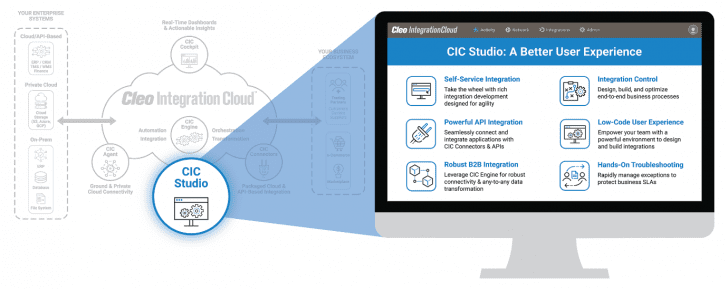
The Studio includes pre-defined templates and grants access to the CIC Connector Library for API-based SaaS, including the Acumatica connector launched earlier this year. The library also has a large number of connectors for on-premise integrations. It includes support for file base integrations which can increase the efficiency of those, legacy integration types.

Vidya Chadaga, vice president of Products at Cleo commented: “The key to thriving in any market environment is having organizational agility to deliver superb customer experiences. Having integration control at your fingertips, through self-service and end-to-end visibility, means everything can be done at higher velocity – faster trading partner onboarding, acceleration of new sales channels, and quicker business outcomes.”
Chadaga’s view is backed by recent research carried out by Dimensional Research, sponsored by Cleo. The 2020 State of Ecosys and Application Integration Report (registration required) found that 30% of respondents lost between $100,000 and $1,000,000 due to integration-related issues. 40% claimed that their inflexible integration infrastructure most impedes revenue. This is where the CIC studio can empower those organisations.
Previously, Cleo Managed Services would step in to deliver the flexibility that organisations. Today, with the launch of CIC Studio, organisations are empowered to help themselves.
The report also noted that for 84% of organisations, having a flexible integration platform is the most important capability for successful integration initiatives. One suspects that the remaining 16% are working within a single platform and require little integration.
Cleo Integration Studio
The CIC Studio enables organisations to create components of integration in five operational categories:
Transport
The Cloud Monitor detects for an event and then triggers a business process to ingest data from an external data source. The Cloud Adapter enables data from the CIC transformation to pass back to an external endpoint.
Define
Using a variety of schemas users can apply metadata to ingested data which helps map to target solutions. Schema types include Database, EDI, JSON, Oracle, SAP, XML and unique connector schemas preconfigured for integration between specific applications such as Salesforce and NetSuite. This leverages the work that Cleo has already completed, further simplifying the task for organisations.
Transform
Users can create rule sets to define how data is changed within the Studio so that it conforms to the required endpoint application schema.
Route
Critical for EDI integrations it defines how data is identified, processed and routed.
Process
This object defines the tasks that are performed on data. It supports three main process types: sequence, comparison and iteration. It enables organisations to build processes that can:
- Execute or launch other objects in your integrations
- Manipulate data (strings and arrays)
- Move or route data based on content
- Analyse documents
- Route envelopes
- Import and export data
More than just a tool
CIC studio is more than just a set of components to help organisations build integrations. It has several platform features that enable organisations to use this for more than just a single integration. Applications, even cloud-based ones, do change schemas, and the CIC Studio supports projects and version control. Users can create projects either to contain reusable packages and objects or for a specific integration. The former is useful when multiple integrations are required for a single application.
Using the Workbench users can create, manage their projects, packages and objects without writing a line of code.
Once an integration project is tested, the organisation can then publish it to the live environment. It enables organisations to monitor and update integrations in a mature environment continuously.
Early adopter Ed Krupka, CIO at Burris Logistics has already seen the benefits. He commented “Agility is synonymous with sustainable success in the age of digital ecosystems, and we rely on Cleo for highly adaptive integrations that speed our innovation. CIC Studio helps us get closer to our customers and partners because their world changes so quickly that our business processes must be primed to accommodate them.”
Enterprise Times: What does this mean
CIC Studio fills a gap. For some organisations, the idea of engaging in managed services to integrate a complex hybrid architecture is expensive and rarely sustainable. CIC Studio gives those organisations the ability to create and manage the integrations themselves in a low code environment. Cleo Managed Services and support services are still there to back up the organisation to answer questions or assist. The CIC Studio will deliver the promise of greater flexibility.
John Santaferraro, Research Director, EMA commented: “Organizations have been handcuffed between the hard choice of owning their integrations themselves or completely outsourcing – with nothing in between. This means businesses have to choose between hiring the technical expertise to manually manage complex integrations, or entirely forego control of their systems, both of which have several downsides. A hybrid approach with both control over key revenue-driving business processes and the support of managed services is what’s needed for an effective integration strategy.”



























